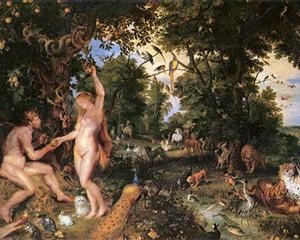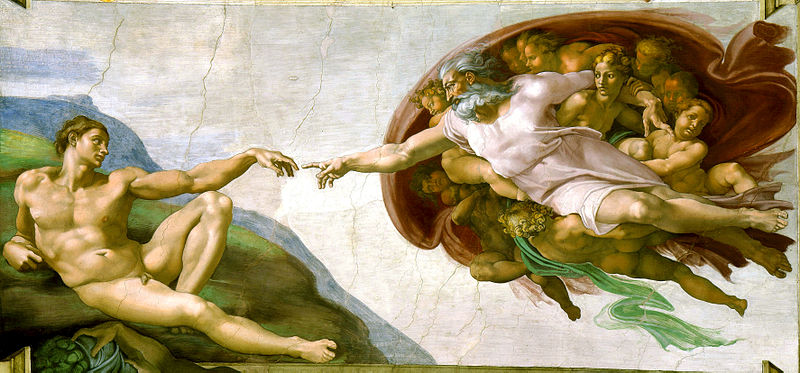 In the blog last week, we discussed the Genesis account, evolutionary theory and how these can be reconciled with Catholic thought and teaching.
In the blog last week, we discussed the Genesis account, evolutionary theory and how these can be reconciled with Catholic thought and teaching.
At one level, the genre for the Genesis accounts must be taken into consideration wherein figurative language is sometimes used to confer the sacred truths that God alone created everything out of nothing. Further, that God oversaw every aspect of creation with intelligence, and purpose, and that he created everything out of nothing, each according to its kind. However the genre, or literary form, of Genesis does not purport to be of nature of a scientific journal article, or of a comprehensive historical genre with exact dates and geographical descriptions. What Genesis tells us is true, but it speaks to us in a summary sort of way, more as a poetic description than an earth science textbook. (More on this HERE). As the Catechism states:
Scripture presents the work of the Creator symbolically as a succession of six days of divine ‘work,’ concluded by the ‘rest’ of the seventh day” ….”nothing exists that does not owe its existence to God the Creator. The world began when God’s word drew it out of nothingness; all existent beings, all of nature, and all human history is rooted in this primordial event, the very genesis by which the world was constituted and time begun” (CCC 337-338).
Material Sufficient Causality? Not! We also discussed that Catholics may be open to the scientific teachings of evolution but that they cannot accept it uncritically, without certain distinctions. Catholics are free to believe in some sort of evolutionary or gradual process as a secondary cause of biodiversity. But we simply cannot accept a theory which says that the sufficient cause and complete explanation of all life is the combination of natural selection and random mutations. The words NATURAL and RANDOM are positively meant to exclude intelligent activity by God by most proponents of the Theory of Evolution. Catholics can come to accept a kind of theistic evolution wherein God is the primary cause of all secondary causes. But we are not free to accept the Theory of Evolution as most commonly proposed without the necessary distinction that natural selection and random mutations are not sufficient causes or a complete explanation for the existence of all things as they are. (More on this HERE).
Here too the Catechism provides an important and balanced approach that respects the role of science but also announces its limits:
The question about the origins of the world and of man has been the object of many scientific studies which have splendidly enriched our knowledge of the age and dimensions of the cosmos, the development of life-forms and the appearance of man. These discoveries invite us to even greater admiration for the greatness of the Creator…..The great interest accorded to these studies is strongly stimulated by a question of another order, which goes beyond the proper domain of the natural sciences. It is not only a question of knowing when and how the universe arose physically, or when man appeared, but rather of discovering the meaning of such an origin: is the universe governed by chance, blind fate, anonymous necessity, or by a transcendent, intelligent and good Being called “God”? (CCC 283-284)
The Problem of Polygenism – There is also another matter which the Theory of Evolution gives rise to that a Catholic must be aware of and realize that he or she cannot give it uncritical acceptance. This is the usual premise in evolutionary theory of polygenism.
Polygenism is a theory of human origins positing that the human race descended from a pool of early human couples, indeterminate in number. Hence, this theory, Adam and Eve are merely symbols of Mankind. Rather than being an historical couple, they represent the human race as it emerges from the hominids that gave rise to them as they become homo sapiens, properly speaking.
This is opposite to the idea of monogenism, which posits a single origin of humanity in Adam and Eve. In this understanding, Adam and Eve are historical figures who actually existed and from them alone the whole of the human race is descended.
Polygenism is the proposed vision of almost all evolutionary theorists. It obviously flows from the theory. As life emerged from one-celled organisms, ultimately more complex forms of life arose to include fish, then reptiles, mammals, higher forms of mammals and early humanoid forms, and then the first homo sapiens. But, presumably this process did not occur only in one case. Rather, it is usually supposed that a larger, indeterminate number of this new species of Man arose. So what we had was an emergent group, rather than simply two individuals: Adam and Eve.
But this presents a problem for a Catholic who might wish to uncritically accept evolution, for, simply put, we cannot accept polygenism. Pope Pius XII in 1950 specifically addressed the problem of polygenism in the Encyclical Humani Generis:
[T]he Teaching Authority of the Church does not forbid that, in conformity with the present state of human sciences and sacred theology, research and discussions, on the part of men experienced in both fields, take place with regard to the doctrine of evolution, in as far as it inquires into the origin of the human body as coming from pre-existent and living matter…..When, however, there is question of another conjectural opinion, namely polygenism, the children of the Church by no means enjoy such liberty. For the faithful cannot embrace that opinion which maintains that either after Adam there existed on this earth true men who did not take their origin through natural generation from him as from the first parent of all, or that Adam represents a certain number of first parents. Now it is in no way apparent how such an opinion can be reconciled with that which the sources of revealed truth and the documents of the Teaching Authority of the Church propose with regard to original sin, which proceeds from a sin actually committed by an individual Adam and which, through generation, is passed on to all and is in everyone as his own (Humani Generis, 36-37).
Hence, it seems clear that a Catholic is not free to accept polygenism. There are some in theological circles who have attempted to assert that the Pope is merely saying it is not apparent how such a theory can be reconciled, but not actually indicating that such a view must be rejected. But this seems fanciful since the Pope says quite clearly that Catholics “by no means enjoy such liberty” and “cannot embrace” the opinion of polygenism. No later Pope or Council has chosen to distinguish or, in any way, limit the conclusion of Pius XII in this matter. Perhaps this does not preclude some eventual theory of polygenism that can be acceptable, but none has yet been offered.
Some Catholics will point to an oversimplified notion presented in the media some ten years ago that science has “proved” that all humans trace their origin to one woman. This woman was dubbed “Eve” or “Mitochondrial Eve.” But, most people have over-simplified understandings of this finding. It does not mean that there were not other women who predated this woman, and other genetic lines that died out. She is merely our most recent common matrilineal ancestor and seems to have lived at a time significantly prior to Y-Chromosomal Adam who is also an important fork in the genetic road. The point is that the theory of one woman is more complicated than the popular conception describes it. [1] It is not likely a resolution to the problem of polygenism.
The heart of the problem in terms of polygenism is, as the Pope notes, the doctrine of original sin as expounded in Scripture:
Therefore, just as sin entered the world through one man, and death through sin, and in this way death came to all men, because all sinned—….Consequently, just as the result of one trespass was condemnation for all men, so also the result of one act of righteousness was justification that brings life for all men. For just as through the disobedience of the one man the many were made sinners, so also through the obedience of the one man the many will be made righteous. (Rom 5:11, 19)
For as in Adam all die, even so in Christ shall all be made alive (1 Cor 15:22)
We are thus all linked not to a group, but to a man, Adam. And when he sinned, we sinned. Sin reaches us all since we all share one common ancestor. Further, it is hard to conceive a group of early humans, all sinning in such as way as all our ancestors went into this state commonly. Scripture says, sin came through one man. Scripture is inerrant in such a matter. We cannot simply set its truth aside.
Scripture also affirms our connection to the one man, Adam when it records that God sent one, Jesus Christ, as the New Adam. This sets up a parallelism: One Adam, One New Adam. God did not send a committee, or a squadron to save us which would be the parallel for polygenism and/or group sin.
So the problem of polygenism is a significant matter for Catholics who want to uncritically accept evolution or understand it in a simplistic and easy-going way. And herein is the central point of this and previous articles of mine on this subject: Namely, it is essential that we make proper distinctions and exclusions if we choose to embrace some aspects of the Theory of Evolution. The Catholic approach to this whole matter is carefully balanced. We are not fundamentalist and creationists but neither do we uncritically accept the Theory of Evolution. We must make proper distinctions, exclusions and clarifications in order to accept what I might term a theistic evolution as a tenable theory. Even here, Catholics are free to reject aspects of a theistic evolution on the grounds of science. But this last distinction (scientific objections) is beyond the role of the Church. Perhaps again, the old advice is helpful here: Seldom affirm, never deny, ALWAYS distinguish. We need to be careful and sober when it comes to Evolutionary Theory.
Perhaps it is good to conclude with the words of Pope Benedict which remind us that we are dealing ultimately with a deep mystery for which we must ultimately have great reverence:
The clay became man at the moment in which a being for the first time was capable of forming, however dimly, the thought of “God.” The first Thou that – however stammeringly – was said by human lips to God marks the moment in which the spirit arose in the world. Here the Rubicon of anthropogenesis was crossed. For it is not the use of weapons or fire, not new methods of cruelty or of useful activity, that constitute man, but rather his ability to be immediately in relation to God. This holds fast to the doctrine of the special creation of man . . . herein . . . lies the reason why the moment of anthropogenesis cannot possibly be determined by paleontology: anthropogenesis is the rise of the spirit, which cannot be excavated with a shovel. The theory of evolution does not invalidate the faith, nor does it corroborate it. But it does challenge the faith to understand itself more profoundly and thus to help man to understand himself and to become increasingly what he is: the being who is supposed to say Thou to God in eternity. (Creation and Evolution: A Conference With Pope Benedict XVI in Castel Gandolfo, S.D.S. Stephan Horn (ed), pp. 15-16)



